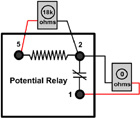
If the ohmmeter reads zero resistance, the contacts are closed, as they should be.
Many low and medium temperature single-phase compressors require some type of external relay to assist in the starting of its motor. The purpose of this relay is to remove the motor’s start winding, start capacitor, or both, from the circuit once the motor is running.
One type of relay commonly used is a potential relay. This relay has a normally closed set of contacts that are wired in series with the motor’s start winding and start capacitor, if used. The coil of this relay is wired in parallel with the motor’s start winding. When the coil is energized, the normally closed set of contacts open, taking the starting winding, start capacitor, or both, out of the circuit.
Since this relay is required in the starting of the motor, one possible cause of a compressor that fails to start is a defective relay. If the relay has an open coil or its contacts welded closed, the starting components of the motors will not be removed from the circuit and the compressor will cycle off on its overload. If the contacts of the relay are stuck open, the starting components will not be in the circuit during the starting of the motor and the motor will not have sufficient torque to start, and again the compressor will cycle off on its overload.
One popular method of troubleshooting this type of relay is using an ohmmeter. Disconnect the voltage source from the circuit and remove the relay from the circuit. First check the relay’s coil by placing the leads of the ohmmeter across the 2 and 5 terminals of the relay. If the ohmmeter reads a high resistance (approximately 3,000 to 18,000 ohms) the coil of the relay is electrically OK. If the coil reads infinite resistance, the coil is electrically open and the relay needs to be replaced.
Next, check the contacts of the relay by placing the leads of the ohmmeter across the relay’s 1 and 2 terminals. If the ohmmeter reads zero resistance, the contacts are closed, as they should be. If the ohmmeter reads a high resistance or an infinite resistance, the contacts are defective and the relay needs to be replaced.
A clamp-on analog ammeter meter can also be used to check the operation of this relay. Set the ammeter to a high scale. Clamp the ammeter around the wire connected to the "1" terminal of the relay. Apply voltage to the motor’s circuit. The needle of the meter should swing high and then drop to zero. If the needle does not move or moves and does not return to zero there may be a problem with the relay. Disconnect the voltage applied to the circuit; remove the relay from the circuit, and using an ohmmeter check the relay's coil and contacts.
Being able to identify a defective relay as the cause of a compressor not starting is an important part of effectively troubleshooting single-phase compressors. Occasionally a good compressor is deemed defective when the true problem is only a defective starting relay.
Publication Date:07/06/2009


Report Abusive Comment